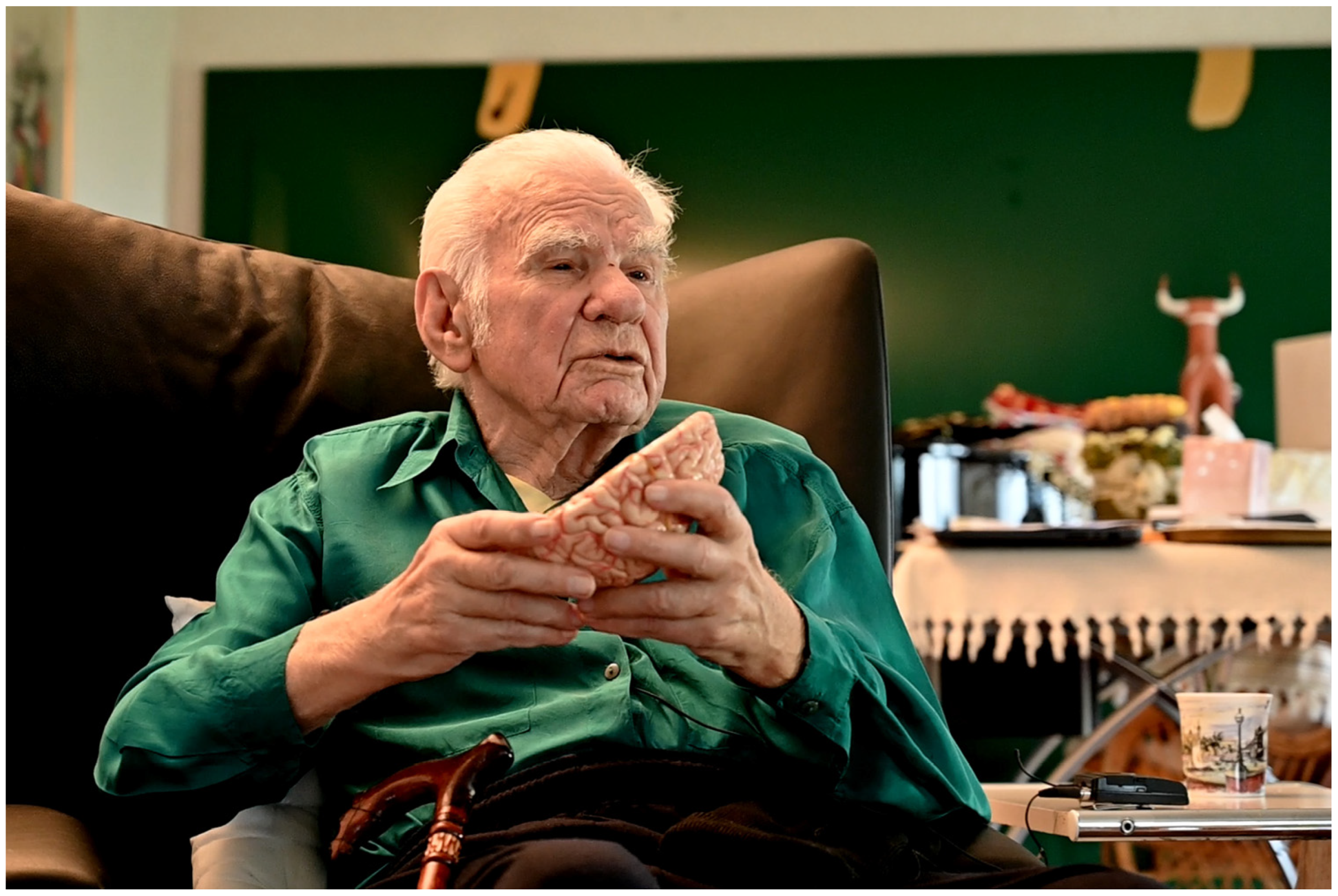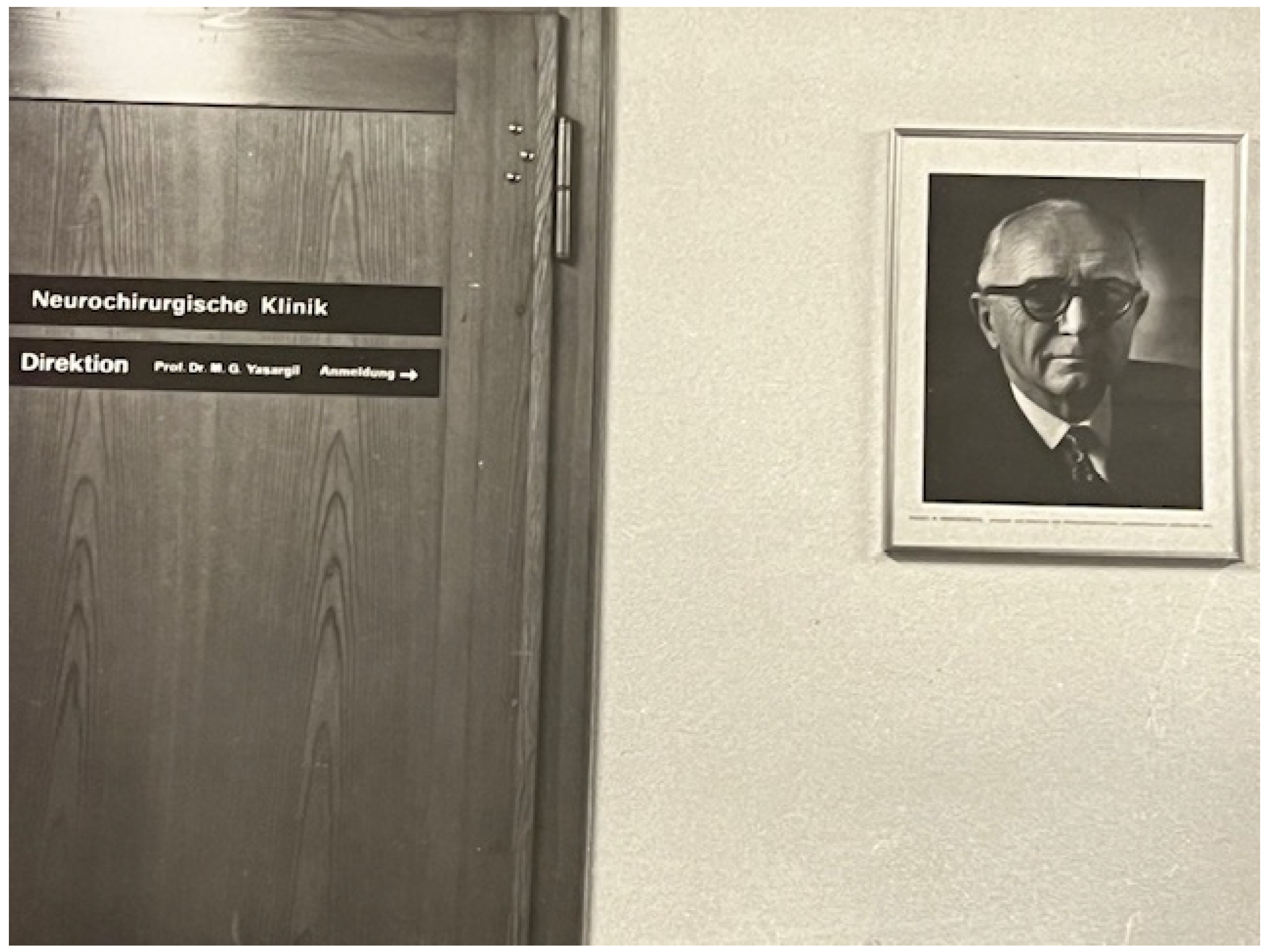MG Yasargil: A Giant Swiss Clinical Neuroscientist (1925–2025)
Abstract
1. Introduction
2. Initial Work
Contributions to the Neurosciences in Switzerland and Worldwide
- (A).
- Neurosurgery:
- (B).
- Contributions to Neuroanatomy:
- (C).
- Contributions to Neurology:
- (D).
- Contributions to Neuroradiology:
3. Late Career and Recognition
4. Discussion
5. Conclusions
Author Contributions
Funding
Institutional Review Board Statement
Informed Consent Statement
Data Availability Statement
Acknowledgments
Conflicts of Interest
Abbreviations
| USZ | Universitätsspital Zürich |
| SFCNS | Swiss Federations of Clinical Neurosciences |
References
- Zander, E. Hugo Krayenbuhl. In Neurosurgical Giants; Bucy, P.C., Ed.; Elsevier: Amsterdam, The Netherlands, 1985; pp. 301–305. [Google Scholar]
- Donaghy, P.D. Mahmut Gazi Yasargil. In Modern Neurosurgical Giants; Bucy, P.C., Ed.; Elsevier: Amsterdam, The Netherlands, 1986; pp. 487–494. [Google Scholar]
- Wallman, L.J. Raymond Madiford Peardon Donaghy. In Modern Neurosurgical Giants; Bucy, P.C., Ed.; Elsevier: Amsterdam, The Netherlands, 1986; pp. 81–86. [Google Scholar]
- Donaghy, R.M.; Yasargil, G. Microangeional surgery and its techniques. Prog Brain Res. 1968, 30, 263–267. [Google Scholar] [PubMed]
- Krayenbuhl, H.; Yasargil, M.G. Cerebral aneurysm. Doc. Geigy. Ser. Chir. 1958, 2, 1–143. (In German) [Google Scholar] [PubMed]
- Krayenbuhl, H.; Yasargil, G. Angiography of collateral cerebral circulation. Acta Neurochir. 1958, 6, 30–80. (In German) [Google Scholar] [PubMed]
- Krayenbuhl, H.; Yasargil, G. Angiography of the subtentorial collateral circulation; path-ogenetic contribution to the clinical aspects of the bulbopontine syndrome. Dtsch. Z. Nervenheilkd. 1957, 177, 103–116. (In German) [Google Scholar]
- Krayenbühl, H.; Yaşargil, M.G. Percutaneous vertebral angiography. Acta. Radiol. Diagn. 1966, 5, 263–266. [Google Scholar] [CrossRef] [PubMed]
- Yaşargil, M.G.; Krayenbühl, H. The use of the binocular microscope in neurosurgery. Bibl. Ophthalmol. 1970, 81, 62–65. [Google Scholar] [PubMed]
- Krayenbühl, H.; Yaşargil, M.G. Use of the surgical microscope in the management of vascular cerebrospinal diseases. Munch. Med. Wochenschr. 1968, 110, 1931–1934. (In German) [Google Scholar] [PubMed]
- Krayenbühl, H.; Yasargil, M.G. Use of the microscope in surgery of the central nervous system. Praxis 1968, 57, 214–217. (In German) [Google Scholar] [PubMed]
- Krayenbühl, H.; Yasargil, M.G. The use of binocular microscopes in neurosurgery. Wien Z. Nervenheilkd. Grenzgeb. 1967, 25, 268–277. (In German) [Google Scholar] [PubMed]
- Yasargil, M.G.; Vise, W.M.; Bader, D.C. Technical adjuncts in neurosurgery. Surg. Neurol. 1977, 8, 331–336. [Google Scholar] [PubMed]
- Yasargil, M.G.; Krayenbuhl, H.A.; Jacobson, J.H., 2nd. Microneurosurgical arterial reconstruction. Surgery 1970, 67, 221–233. [Google Scholar] [PubMed]
- Krayenbühl, H.; Yaşargil, M.G. Diagnosis and therapy of intracranial aneurysms. Surg. Annu. 1970, 2, 327–343. [Google Scholar] [PubMed]
- Yasargil, M.G. Die Vertebralis Angiographie; Springer: Berlin/Heidelberg, Germany, 1962. [Google Scholar]
- Yasargil, M.G. Microsurgery Applied to Neurosurgery; Georg Thieme: Stuttgard, Germany; Academic Press: New York, NY, USA; London, UK, 1969. [Google Scholar]
- Yasargil, M.G. Microneurosurgery; Georg Thieme: Stuttgard, Germany, 1969; Volume 1–4. [Google Scholar]
- Yasargil, M.G. The results of stereotactic operations in hyperkinesia. Schweiz. Med. Wochenschr. 1962, 92, 1550–1555. (In German) [Google Scholar] [PubMed]
- Krayenbuhl, H.; Yasargil, M.G. Results of stereotactic operations in parkinsonism, especially bilateral surgery. Dtsch. Z. Nervenheilkd. 1961, 182, 530–541. (In German) [Google Scholar]
- Mueller, C.; Yasargil, M.G. On the psychiatric aspects of stereotactic brain surgery in extrapyramidal disorders. Schweiz. Arch. Neurol. Neurochir. Psychiatr. 1959, 84, 136–154. (In German) [Google Scholar]
- Krayenbuhl, H.; Hess, R.; Weber, G. Electroencephalographic, corticographic, and surgical considerations on 21cases of temporal epilepsy treated by cortical excision and lobectomy. Rev. Neurol. 1953, 88, 564–567. (In German) [Google Scholar]
- Krayenbuhl, H. On the classification and treat-ment of epilepsy. Praxis 1953, 42, 259–260. (In German) [Google Scholar]
- Krayenbuhl, H.; Hess, R.; Weber, G. Electroencephalographic and therapeutic results in the treatment of 21 cases of so-called temporal lobe epilepsy. Zentralbl. Neurochir. 1954, 14, 206–211. (In German) [Google Scholar]
- Krayenbuhl, H. Diagnosis and treatment of so-called late epilepsies. Schweiz. Med. Wochenschr. 1957, 87, 1–5. (In German) [Google Scholar] [PubMed]
- Yaşargil, M.G.; Krayenbühl, N.; Roth, P.; Hsu, S.P.; Yaşargil, D.C. The selective amygdalohippocampectomy for intractable temporal limbic seizures. J. Neurosurg. 2010, 112, 168–185. [Google Scholar] [CrossRef] [PubMed]
- Krayenbühl, H.; Yasargil, M.G. Die Zerebrale Angiographie: Lehrbuch für Klinik und Praxis; Georg Thieme: Stuttgard, Germany, 1965. [Google Scholar]
- Valavanis, A.; Yaşargil, M.G. The endovascular treatment of brain arteriovenous malformations. Adv. Tech. Stand. Neuro-Surg. 1998, 24, 131–214. [Google Scholar]
- Available online: https://en.wikipedia.org/wiki/Gazi_Ya%C5%9Fargil (accessed on 22 June 2025).
- Available online: https://swissneuroradiology.ch/de/portrait/geschichte/ehrenmitglieder (accessed on 22 June 2025).
- Available online: https://www.swissneurosurgery.ch/ueber-uns/portrait/ehrenmitglieder (accessed on 22 June 2025).
- Tew, J.J.M.M. Gazi Yasargil: Neurosurgery’s man of the century. Neurosurgery 1999, 45, 1010–1014. [Google Scholar] [CrossRef] [PubMed]
- Penfield, W. All hail to a master Neurosurgeon. Schweiz. Arch. Neurol. Neurochir. Psychiatrie 1972, 111, 111–112 . [Google Scholar]


Disclaimer/Publisher’s Note: The statements, opinions and data contained in all publications are solely those of the individual author(s) and contributor(s) and not of MDPI and/or the editor(s). MDPI and/or the editor(s) disclaim responsibility for any injury to people or property resulting from any ideas, methods, instructions or products referred to in the content. |
© 2025 by the authors. Published by MDPI on behalf of the Swiss Federation of Clinical Neuro-Societies. Licensee MDPI, Basel, Switzerland. This article is an open access article distributed under the terms and conditions of the Creative Commons Attribution (CC BY) license (https://creativecommons.org/licenses/by/4.0/).
Share and Cite
Lövblad, K.-O.; Schaller, K.; Guzman, R.; Bassetti, C.; Regli, L. MG Yasargil: A Giant Swiss Clinical Neuroscientist (1925–2025). Clin. Transl. Neurosci. 2025, 9, 36. https://doi.org/10.3390/ctn9030036
Lövblad K-O, Schaller K, Guzman R, Bassetti C, Regli L. MG Yasargil: A Giant Swiss Clinical Neuroscientist (1925–2025). Clinical and Translational Neuroscience. 2025; 9(3):36. https://doi.org/10.3390/ctn9030036
Chicago/Turabian StyleLövblad, Karl-Olof, Karl Schaller, Raphael Guzman, Claudio Bassetti, and Luca Regli. 2025. "MG Yasargil: A Giant Swiss Clinical Neuroscientist (1925–2025)" Clinical and Translational Neuroscience 9, no. 3: 36. https://doi.org/10.3390/ctn9030036
APA StyleLövblad, K.-O., Schaller, K., Guzman, R., Bassetti, C., & Regli, L. (2025). MG Yasargil: A Giant Swiss Clinical Neuroscientist (1925–2025). Clinical and Translational Neuroscience, 9(3), 36. https://doi.org/10.3390/ctn9030036






